Hauntings on the home front
by Karin Salvalaggio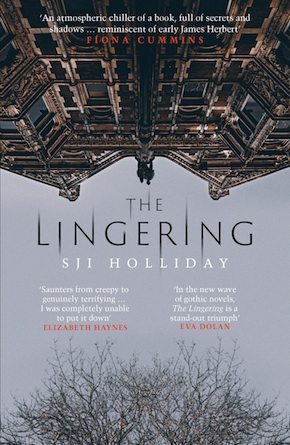
“Brilliantly chilling and perfectly paced.” Anna Mazzola
If my recent reading list is anything to go by, crime novels that touch on the paranormal are growing in popularity. Often set in houses that evoke an atmosphere of fear and dread, many of these storylines have elements found in Gothic horror. The reader is left to decide whether the house is truly haunted or it’s down to a character’s imagination. Novels such as Shirley Jackson’s The Haunting of Hill House, S.J.I. Holliday’s The Lingering, and W.C. Ryan’s The House of Ghosts leave the reader in no doubt, whereas Laura McHugh’s Arrowood, Michael J. Malone’s House of Spines, Claire Fuller’s Bitter Orange (claiming it as a crossover), and Fiona Cummins’ Rattle keep the reader guessing.
I found the many parallels between S.J.I. Holliday’s The Lingering and Michael J. Malone’s The House of Spines fascinating, given how much their novels vary in style, content, and tone. They were kind enough to agree to an interview to explore this.
KS: My parents had Daphne Du Maurier’s short story collection Not After Midnight on their bookshelf sitting alongside The Exorcist. I was only nine years of age and both books were strictly forbidden, which is exactly why I read them. I don’t remember The Exorcist having much of an impact, but Du Maurier’s short story ‘Don’t Look Now’ gave me nightmares for weeks. What books scared you as children and why? Have you recently come across any novels that have made you want to leave the light on all night?
MJM: The first book I remember scaring me was Treasure Island. I must have been around seven or eight and that black spot thing haunted me, as did Long John Silver. He was terrifying and fascinating in equal measure to my young mind. A novel I read recently that freaked me out was The Shining. Of course I’ve watched and loved the movie, and when I heard that Stephen King was publishing the follow-up, Dr Sleep, I thought I should check out the first book. I had to put it down regularly. A spooky classic!
SJIH: Coming across a box full of late 70s/early 80s pulp horror including John Halkin’s Slither is what did it for me. My mum read all James Herbert’s and Shawn Hutson’s novels – all the stuff with hideous covers. Check out Slither if you want to have nightmares! The Woman in Black also chilled me to the bone. And most recently Laura Purcell’s The Silent Companions has come very close.
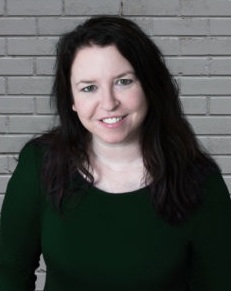
S.J.I. Holliday
With so many world events making us anxious, why do we actively seek out books that frighten us even more?
SJIH: Escapism. Because a good book usually has a good resolution, where the fictional world order is restored. We can be scared in a safe space, knowing that when we close the book, the scary things are trapped inside. It’s not real. It’s an adrenaline buzz to scare yourself and know that you’ll still be OK. Not so easy to say that about the real world right now!
MJM: What Susi said. Actually, if Stephen Pinker is to be believed, the world is a far safer place than it’s ever been. And bringing Noam Chomsky into the conversation, all this promoted fear is just a way of keeping the population fighting among themselves and compliant so the ultra-rich can carry on making even more money. But that’s a subject for another conversation… If you look at places that are actually scary and dangerous, crime fiction is the very last thing that people will be reading. A good example of this is how long it took for crime writers from Northern Ireland to start writing about that time in their history. They certainly weren’t doing it while the Troubles were happening. As for seeking out books that frighten us, there’s a drive for the ‘safe scare’, isn’t there? Like the rollercoaster or any other thrill ride at the fairground, we know we are actually safe, but a wee shot of adrenaline goes down a treat and is a great way to de-stress from everyday life.
Certain readers are staunchly against paranormal/supernatural elements and refuse to entertain it all, no matter how compelling you make it. But there has always been an audience for ghost stories.”
I recently came across the use of paranormal elements in an otherwise mainstream crime novel called The Silence of the Sea by Yrsa Sigurðardóttir. I found the addition quite puzzling until I sat on a panel with the author at Bouchercon. It turns out that more than 50 per cent of Icelanders believe in elves. Not so jarring when you have cultural context. Do you feel it’s necessary to have an audience that is at the very least receptive to, or fully believes in the supernatural world, or is it simply a matter of creating an interesting cast of characters and compelling storyline to suspend disbelief?
SJIH: I love that fact about the elves. Iceland is steeped in folklore, and it’s great that it still shapes them and makes them unique. I think you will get certain readers who are staunchly against paranormal/supernatural elements and refuse to entertain it all, no matter how compelling you make it. Some may be on the fence and will be appeased if these things are explained as all in the mind. But there has always been an audience for ghost stories, a lot of this coming from a time when people really didn’t understand death. The Victorians were fascinated by death, often taking death portraits of their loved ones, for example. They had a strong belief in an afterlife. Religion has a part to play in it too – isn’t heaven a paranormal construct? But for the modern reader, I think you have to be quite clear from the outset about what you are doing – either explain the weird happenings with a rationale or make it explicit that these things can’t be explained, because the characters themselves are unable to explain them. The worst thing you can do is mislead the reader. If you are using supernatural elements, it has to be at least hinted at throughout. It’s not OK to get to the last chapter and say “A GHOST DID IT!” Oh, and you definitely don’t have to believe to be believable. One of the biggest experts on ghosts I know, who writes about them beautifully, is A.K. Benedict, and she doesn’t believe in them at all.
MJM: I couldn’t agree more. Some people just don’t buy into the supernatural in a book (or otherwise), and regardless of the quality of the writing will not suspend their disbelief long enough to finish the read. Personally, I enjoy it. I think it’s a limiting view to think that only things that we can perceive within the bounds of our senses can be real. However, I was aware of those opposing views while I was writing House of Spines, and as I was working through the first draft I couldn’t decide whether or not the determining factor should be a delusion in the character’s mind or something otherworldly. In the end I decided to make both outcomes possible and leave it to readers to make up their own mind. And their reviews suggest they did just that. Readers who have no truck with the supernatural plumped for a scientific explanation, while ‘other-minded’ readers labelled it as supernatural.
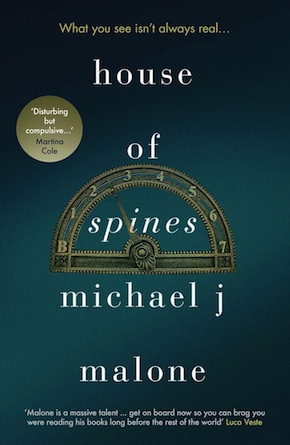
“Original, engrossing and scary.” The Times
In House of Spines, the Fitzgeralds’ sprawling mansion with its tower, broken lift, and abandoned wing, provides not only a backdrop, but possibly a metaphor for the central character’s troubled mind. The Lingering features Rosalind House, a vast and semi-derelict insane asylum with a dark past that is now home to an alternative community known for embracing the light. In Gothic horror the house where the novel is set often harbours its own secrets and, in the words of David De Vore, “not only evokes the atmosphere of horror and dread, but also portrays the deterioration of its world.” What is it about these vast properties that inspires you most? Did the house shape the narrative or did the narrative shape the house?
MJM: My main character Ronald McGhie inherits the mansion from a side of the family he never knew existed. In the first few chapters the house became for me like a wish-fulfilment exercise: a massive library, swimming pool, TV room, walk-in wardrobe, etc. But for Ronald it’s not quite so simple. Near the start of the book I have another character inject a note of worry, and it came from a friend of mine whose mother on a sunny day would say, “Aye, but we’ll pay for it tomorrow.” There’s a fatalistic attitude that some Scots people have. I wanted to play on that attitude and the house was a big part of this message. In answer to your question, I’m not sure what shaped what, to be honest. I just knew that the house had to be a big part of the action, and not just part of the backdrop. And with these vast properties I think they promote a range of emotions in us mere mortals, from envy to suspicion. Envy obviously coming from comparison – I live in a shithole and you’ve got all that? And suspicion in the sense of HOW did your family manage to accumulate it all? So if something goes wrong we get to experience a little frisson of schadenfreude that obviously in real life we’d be too kind to go with. In a book, that’s allowed.
SJIH: In The Lingering, I have an old crumbling Victorian asylum that is now home to a small spiritual commune. There is far too much space for the number of inhabitants, and much of the building is out of bounds, for both safety reasons and the fact that it is just too creepy. I like the idea of there being a small group of people in a house that is far too big for them. It lends itself to weird happenings, of a real and imagined nature, and gives the impression of the house being this huge, looming entity that none of them can control. There is something about creepy old buildings that fascinates me, and the more I developed the idea of the building (based on a real old asylum), the more it determined how the characters behaved within it. My building is the opposite of Michael’s, none of that feeling of it being a place to aspire to, more of it being a place to defer to. I certainly wouldn’t spend a night in either mine or Michael’s inventions, that’s for sure!
The mind is a fascinating thing, and I think that also plays to the supernatural. Is it real or isn’t it? Does anyone really know?”
There’s a great deal in your novels about mental illness and the misuse and abuse of mind-altering pharmaceuticals, as well as historical abuse experienced by patients treated in asylums. The Lingering highlights a twisted, co-dependent relationship between a former mental-health nurse Ali and her husband Jack, which is far more troubling than it first appears. Ranald, the main character in House of Spines, is bipolar and has serious abandonment issues. He slips on and off medication overconfident about his natural hold on reality. These characters are wonderfully unreliable. The reader has no idea whether their memories and observations are real or imagined. You tackle the interface between the real and supernatural worlds differently, one of you leaving us in no doubt that your house was indeed haunted while the other provides us with a more ambiguous ending. How did you use mental illness and drug misuse to shape the narrative? You both seem quite knowledgeable. What sort of research did you do?
SJIH: The research part was easy for me as it’s my day job. I work as a pharmaceutical statistician, so I was able to put a lot of that knowledge to good use – although of course I used some poetic licence. It was important for me to bring the effects of drugs into the modern-day element of my story, to reflect the types of things that went on in the past when the place was an asylum. Control is probably the unintentional theme of The Lingering, shown through the eyes of the main characters but also through the history of the place – what used to happen there, elements of history repeating itself. The mental-illness parts involved lots of internet research, but also speaking to my mum, who was a psychiatric nurse in the 70s and has many gruesome tales of the hospitals she worked in. It’s an important topic so it’s essential that it’s explored in fiction. The mind is a fascinating thing, and I think that also plays to the supernatural. Is it real or isn’t it? Does anyone really know? Despite my scientific brain trying to cast rational explanations, the creative part of me, and my subconscious, want to believe otherwise.

Michael J. Malone
MJM: With regard to mental illness and drug misuse, I spoke to a handful of people living with bipolar, watched some TV documentaries, and read diary entries from bipolar patients, all of which helped form my characterisation of Ranald, which happily – in regard to the story at least – lends itself to that whole unreliable narrator situation. It is an incredibly tricky condition to manage, not least because the highs are SO high that some don’t want to live without them even given the incredibly deep troughs they fall into in their darker times, which can last for months and months. I was actually taken to task by one reviewer for ‘using’ this condition. On balance she forgave me because it was sympathetically done. I didn’t comment back but I was thinking, FFS, is that something else we’re not supposed to write about now?!
The Lingering is set near a town infamous for 16th-century witch trials that resulted in the executions of innocent women, and House of Spines shines a spotlight on the vulnerability of young women who worked in service for wealthy families. Did you set out to highlight the historical mistreatment of women? If so, why?
MJM: Aside from the central idea – young man inherits house from a side of the family he had no idea even existed – there was little that I deliberated over in this book. I write instinctively and allow the story to unfold in the writing of it. It’s only in the rewrite that I interrogate what I’ve come up with and question if it’s working. I think as writers we store all sorts of stuff in our subconscious and then it throws it up when were are in the flow. It was only later that I questioned where this part of the plot came from, and I’m pretty sure it was something about the novel by Maggie O’Farrell called The Vanishing Act of Esme Lennox. A young unmarried woman falls pregnant and is sent to a lunatic asylum, something that happened to lots of young women. Appalling stuff. My storyline goes in a different direction, but that situation as described by Maggie O’Farrell has haunted me.
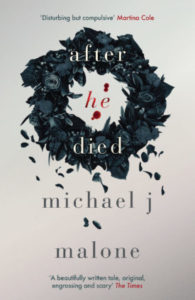
“Vivid, visceral and compulsive.” Ian Rankin
SJIH: I have always been fascinated by asylums, and in particular the reasons women were often put there. It was a terrifying time and it makes me think that no matter how much people complain now, it wasn’t as bad as that! The witches element came naturally from the area where the book is set, and the two seemed to combine nicely with the present-day storyline. I didn’t intentionally set out to write about the mistreatment of women in any era, but it seems to have organically unfolded as a theme, along with isolation and loneliness and a need to belong to something.
What are you working on now? Will you continue exploring the supernatural world in future projects, or was this a one-off?
MJM: In my latest book After He Died, Paula Gadd’s husband of nearly thirty years has passed away and at his funeral a young woman approaches Paula, slips something into her pocket and whispers, “You need to know who your husband really was.” What follows places both of these women in very real danger. At the moment, I’m working on a novel about families and secrets – a family mystery. I can’t say more at this moment as I’m still working out what is going on here. With regards to writing more in the supernatural I have no plans to do so at the moment, but I had great fun writing House of Spines and would love to get back to that sort of writing in the future.
SJIH: I’m working on a couple of different things at the moment, and I am a bit superstitious about revealing any storyline before I have them fully worked out, but there will definitely be some spooky elements in the next book, and a historical element too.
Michael J. Malone is a prize-winning poet and author. His debut novel Blood Tears won the Scottish Association of Writers’ Pitlochry Prize. He is also the author of A Taste for Malice, The Guillotine Choice, Beyond the Rage, The Bad Samaritan and A Suitable Lie. House of Spines and After He Died are published by Orenda Books in paperback and eBook.
Read more
mjm-ink.com
@michaelJmalone1
S.J.I. (Susi) Holliday is a pharmaceutical statistician and crime and horror writer. Her previous books are
the Banktoun trilogy (Black Wood, Willow Walk and The Damselfly) featuring Sergeant Davie Gray, and
the festive serial killer thriller The Deaths of December. The Lingering is out now from Orenda Books.
Read more
susiholliday.com
@SJIHolliday
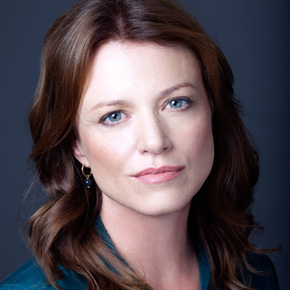 Karin Salvalaggio is the author of the Macy Greeley crime novels Bone Dust White, Burnt River, Walleye Junction and Silent Rain and a contributing editor at Bookanista. Her fiction to date is set in towns that border the Montana wilderness, a uniquely spectacular landscape she fell in love with as a child. Her proudly independent characters inhabit stories about the American dream gone wrong. She is currently working on the final edits of a psychological thriller set closer to home in West London, where she has lived since 1994. The characters may be hemmed in by glass and steel, but the stories they tell are just as compelling.
Karin Salvalaggio is the author of the Macy Greeley crime novels Bone Dust White, Burnt River, Walleye Junction and Silent Rain and a contributing editor at Bookanista. Her fiction to date is set in towns that border the Montana wilderness, a uniquely spectacular landscape she fell in love with as a child. Her proudly independent characters inhabit stories about the American dream gone wrong. She is currently working on the final edits of a psychological thriller set closer to home in West London, where she has lived since 1994. The characters may be hemmed in by glass and steel, but the stories they tell are just as compelling.
karinsalvalaggio.com
@KarinSalvala

